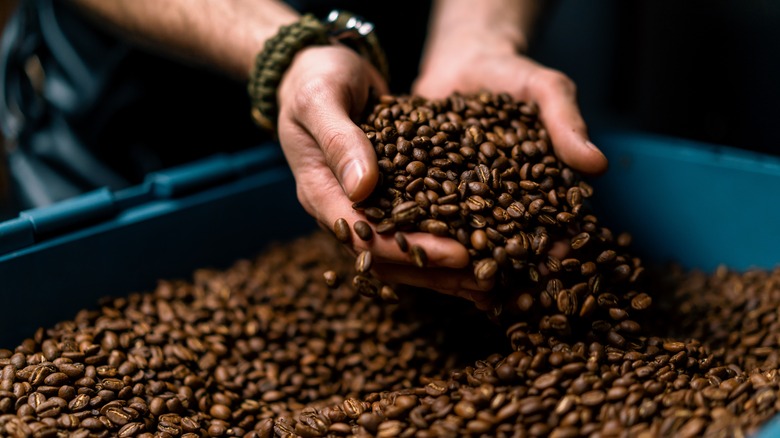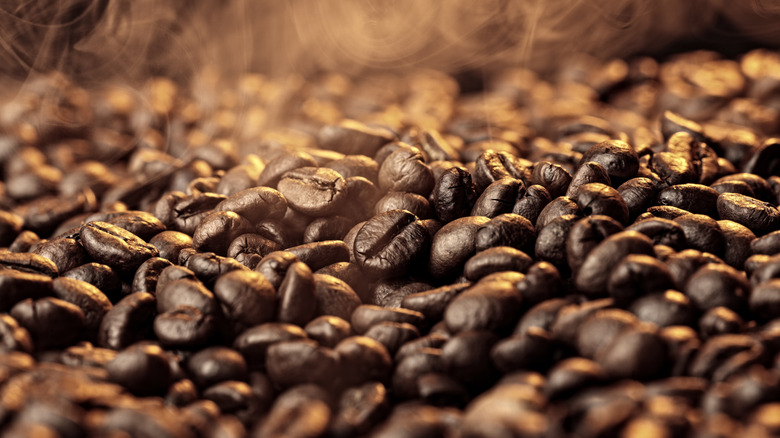Why You Don't Need To Worry About The Mold In Your Coffee
Gross as it is, you have to give mold one thing: It's incredibly resourceful. It can form a colony on just about anything, from dirty walls, clothes, plants, and even coffee. Yes, coffee — the plant and the cherries alike — aren't immune to mold. It's a pretty big problem in the coffee world. In fact, if you've been reading about coffee for long enough, you'll have heard of mycotoxin, which is a toxin secreted by various molds that are known to infect coffee crops of all kinds, from Arabica to Canephora species.
Needless to say, absolutely no one wants to have anything that ends in "-toxin" within their morning coffee. Unfortunately, it's tough to find coffee that's completely free of mycotoxins. A study in the journal Food Research International made 269 isolates from a batch of coffee and found that up to 75% are capable of producing Ochratoxin A (OTA), one of the types of mycotoxins that can affect coffee crops. And even though health authorities everywhere are aware of the risks and have tried to eliminate them, OTA is found in a relatively high amount of coffee sold around the world.
But the good news is that you don't have to go on a coffee diet permanently! Our current understanding of mycotoxin and mold makes it clear that they're usually safe to consume — within limits.
The dose makes the poison
Here's the deal: While you'll find traces of mycotoxins in almost every batch of coffee, they're present in very small amounts. When you buy coffee from or imported to the EU, it has to comply with EU regulations on mycotoxin levels. For instance, roasted coffee beans shouldn't have more than 3 micrograms per kilogram, and for instant coffee, the rule is 5 micrograms per kilogram. Similar rules exist in other regions, so the coffee you buy — no matter the origin — is usually well within safe limits.
So, there's no need to fret when you're sipping your morning brew. Plus, because mycotoxins are such a hot topic that loads of research has been done to figure out whether they're truly harmful or not. Thankfully, research has shown that even if you drink up to 28 cups a week (around four cups a day), your mycotoxin intake should be around 2% of the weekly safe limit, per a study published in the journal Food Additives and Contaminants. So, even if you're a coffee fiend and drink more than that, the caffeine you're scarfing down is more notable than the mycotoxins.
How producers take out mycotoxin in their products
Practically every coffee grower deals with mycotoxins, but how they handle them varies widely from place to place and even from farm to farm. One common method is the wet processing technique. This involves soaking the coffee beans in water to strip away the outer layers of the coffee cherries. Then, they're left to ferment in water, which helps develop the coffee's flavor and washes away most of the molds and toxins.
However, the most effective way to eliminate mold and toxins is through the coffee roasting process. According to a study in the Journal of Agricultural and Food Chemistry, roasting can remove anywhere from 69 to 96% of OTA (Ochratoxin A), and you can do this right in your kitchen.
By the time coffee beans have gone through all the processing and become grounds ready for brewing, even if there are tiny traces of contaminants left, they shouldn't pose any health risk at all. So go ahead and feel free to enjoy that fancy French noisette!


